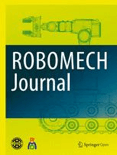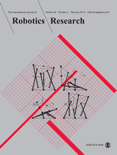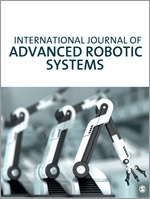
ROBOMECH Journal
Scope & Guideline
Pioneering Discoveries in Robotics and Mechanical Engineering
Introduction
Aims and Scopes
- Robotics and Automation:
The journal emphasizes the design, control, and application of robotic systems in various domains, including industrial, medical, and service robots. - Mechatronic Systems and Control:
Research related to the integration of mechanical, electronic, and software components to create advanced mechatronic systems is a core focus, highlighting control methodologies and system dynamics. - Soft Robotics and Actuation Techniques:
The journal explores innovative actuation methods, particularly soft actuators and biomimetic designs, which enhance flexibility and adaptability in robotic systems. - Artificial Intelligence in Robotics:
Application of AI techniques, including machine learning and neural networks, for improving robotic perception, decision-making, and autonomous operation. - Human-Robot Interaction:
The journal addresses the design and implementation of systems that facilitate effective interaction between humans and robots, emphasizing usability and user experience. - Sensor Technologies and Data Fusion:
Research on advanced sensor systems and data fusion techniques that improve the environmental perception and situational awareness of robotic systems. - Mobile and Autonomous Systems:
Focus on the development of mobile robotics, including navigation, localization, and obstacle avoidance, crucial for applications in dynamic environments.
Trending and Emerging
- Neural Networks and Machine Learning:
There is an increasing trend in the application of neural networks and machine learning techniques for various robotic tasks, including perception, control, and decision-making, showcasing the integration of AI in robotics. - Soft Robotics:
Soft robotics is gaining traction, with more studies focusing on soft actuators and materials that mimic biological organisms, enabling robots to interact safely and effectively with humans and their environments. - Human-Centric Robotics:
Research emphasizing human-robot interaction and collaboration is on the rise, indicating a shift towards developing robots that work alongside humans in shared environments. - Teleoperation and Remote Control Systems:
With advancements in communication technologies, there is a growing interest in teleoperation systems that enhance remote control capabilities, particularly in hazardous environments. - Multi-modal Sensing and Perception:
The integration of various sensing modalities to improve environmental understanding and responsiveness in robots is increasingly prevalent, reflecting the need for more sophisticated perception systems. - Robotics for Health and Rehabilitation:
Emerging applications of robotics in healthcare, including rehabilitation devices and assistive technologies, highlight the journal's focus on socially impactful research. - Game Theory and Robotics:
The application of game-theoretic approaches to robotic maneuvering and decision-making is gaining interest, reflecting a trend towards strategic interaction models in multi-robot systems.
Declining or Waning
- Traditional Mechanical Systems:
Research focused solely on conventional mechanical systems without integration of advanced control or sensing technologies is becoming less frequent as the field advances towards more intelligent and adaptive systems. - Low-level Control Algorithms:
There is a noticeable decrease in publications centered around basic control algorithms, as the focus shifts towards higher-level decision-making processes and AI-driven approaches. - Static Robotics Applications:
Studies that emphasize static or non-mobile robotic applications are declining, with more emphasis now on dynamic and mobile systems capable of operation in real-world environments. - Basic Robotic Components:
Research on fundamental robotic components, such as simple actuators and gears, is less prevalent, as the field moves towards integrated systems with multi-functional capabilities.
Similar Journals

Robotics, published by MDPI in Switzerland, stands at the forefront of interdisciplinary research, focusing on the latest advancements in robotics, artificial intelligence, control systems, and mechanical engineering. As an Open Access journal since 2012, it aims to disseminate high-quality research and innovative findings to a global audience, promoting collaboration among researchers, professionals, and students alike. With a commendable impact reflected in its 2023 categorizations—including Q2 rankings in Artificial Intelligence and Control and Optimization, and a prestigious Q1 in Mechanical Engineering—the journal underscores its significance within the scientific community. Notably, it boasts impressive Scopus rankings, standing within the top 20% in Mathematics and Control and Optimization. Robotics is dedicated to advancing knowledge and practice in the robotics domain, providing readers with valuable insights into emerging trends and technologies that shape the future of the field.

Intelligent Service Robotics
Pioneering Insights: Where Robotics Meets Intelligent InnovationIntelligent Service Robotics, published by SPRINGER HEIDELBERG, is a leading journal that focuses on the transformative intersection of intelligent systems and robotics, establishing itself as a pivotal resource for researchers, professionals, and students in the fields of Artificial Intelligence, Computational Mechanics, and Mechanical Engineering. With an impressive impact factor reflective of its relevance—featuring a 2023 Q1 ranking in Computational Mechanics and Mechanical Engineering, and Q2 in Artificial Intelligence—this journal disseminates high-quality, peer-reviewed research that propels innovation and application in various engineering disciplines. Operating from its headquarters in Heidelberg, Germany, Intelligent Service Robotics aims to foster a dynamic academic community, encouraging open dialogue and collaboration among thought leaders and emerging scholars alike. The journal invites submissions that provide novel insights and solutions in the rapidly evolving landscape of service robotics, ensuring that it remains at the forefront of scientific discourse. With a converged publication timeline from 2008 to 2024 and robust Scopus rankings, the journal is committed to shaping the future of robotic intelligence and its applications.

AUTONOMOUS ROBOTS
Advancing Knowledge in Robotic Autonomy.AUTONOMOUS ROBOTS, published by SPRINGER, is a leading academic journal that serves as a pivotal platform for the dissemination of cutting-edge research in the field of Autonomous Robotics. With an ISSN of 0929-5593, this esteemed journal has been at the forefront of innovation since its inception in 1994, and it continues to thrive with a vision extending to 2024 and beyond. Recognized in the Q1 category of Artificial Intelligence, it boasts a commendable ranking of #85 out of 350 in Computer Science and Artificial Intelligence, positioning it within the 75th percentile of researchers' preferred publications. The journal features a range of subjects related to autonomous systems, including but not limited to robot perception, action planning, multi-agent systems, and autonomous interactions, catering to an audience that spans researchers, industry professionals, and students alike. Scholars can access a wealth of peer-reviewed articles that contribute to both theoretical frameworks and practical applications, ensuring the relevance of the work published within its pages. Located in Dordrecht, Netherlands, AUTONOMOUS ROBOTS exemplifies a commitment to advancing the science of robotics, making significant contributions to the knowledge base and inspiring new developments within the field.

INTERNATIONAL JOURNAL OF ROBOTICS RESEARCH
Unveiling the Future of Robotics ResearchINTERNATIONAL JOURNAL OF ROBOTICS RESEARCH (ISSN: 0278-3649, E-ISSN: 1741-3176), published by SAGE PUBLICATIONS LTD, is a leading journal in the fields of robotics and engineering. With an impressive impact factor and recognized as a Q1 journal in various categories including Applied Mathematics, Artificial Intelligence, Electrical and Electronic Engineering, Mechanical Engineering, Modeling and Simulation, and Software, it has established itself as an essential resource for researchers and practitioners alike. The journal covers a wide array of topics relevant to the advancing disciplines of robotics, ensuring comprehensive perspectives on both theoretical and practical applications. Notably, it ranks at the top percentile in Scopus rankings across multiple fields, which underscores its significance in the research community. Published continuously since 1982, the journal invites submissions that push the boundaries of robotics research, offering a platform for innovative ideas and solutions that address complex engineering problems. While it operates under a subscription model, its vast reach and reputation make it an invaluable resource for advancing knowledge in robotics.

Frontiers in Neurorobotics
Unlocking the Potential of Robotics with Neural ScienceFrontiers in Neurorobotics is a leading open access journal that bridges the fields of artificial intelligence and biomedical engineering, dedicated to advancing the understanding and application of neural mechanisms in robotics. Published by FRONTIERS MEDIA SA in Switzerland, this journal has been disseminating innovative research since its inception in 2007. With an aim to foster interdisciplinary collaboration and share cutting-edge findings, Frontiers in Neurorobotics holds a commendable position in the academic landscape, ranking in the Q2 category for both Artificial Intelligence and Biomedical Engineering as of 2023. Researchers will find it particularly valuable due to its broad scope, which encompasses everything from theoretical frameworks to practical applications in neurorobotics. The journal is committed to open access, ensuring that its contents are readily available to a global audience, thus enhancing visibility and engagement with trailblazing research in this dynamic field.

Robotic Intelligence and Automation
Pioneering Insights in Robotics and Artificial Intelligence.Robotic Intelligence and Automation is a pioneering academic journal dedicated to the exploration and advancement of knowledge within the realms of robotics, artificial intelligence, and automation technologies. Published by EMERALD GROUP PUBLISHING LTD in the United Kingdom, this journal serves as a critical platform for researchers, professionals, and students who strive to understand and innovate in these rapidly evolving fields. With an impressive visibility across multiple disciplines, it has achieved a respectable Q2 ranking in Computer Science Applications, Control and Systems Engineering, Electrical and Electronic Engineering, and Industrial and Manufacturing Engineering, while also being recognized in Q3 for Artificial Intelligence and Human-Computer Interaction. The journal boasts a comprehensive Open Access model, allowing broad dissemination of research findings, which is vital for fostering collaboration and learning within the scientific community. Researchers can look forward to contributing to a publication that not only addresses current challenges but also seeks to shape the future of intelligent automation and robotics.

Journal of Field Robotics
Pioneering Innovations in Real-World RoboticsJournal of Field Robotics, published by WILEY, is an esteemed peer-reviewed journal focusing on the cutting-edge developments in the area of robotics applied to real-world environments. With an ISSN of 1556-4959 and an E-ISSN of 1556-4967, this journal serves as a vital platform for researchers and professionals keen on advancing the fields of Computer Science Applications and Control and Systems Engineering, where it has earned a prestigious Q1 ranking in both categories as of 2023. The journal, which converges in its studies from 2006 to 2024, showcases original research that enhances the understanding and implementation of robotic systems in various fields, thus promoting innovative solutions to complex challenges. Access to the journal is through subscription-based options, ensuring a rigorous selection of high-quality research articles, reviews, and technical notes that contribute significantly to the academic community. With a solid Scopus ranking—39th out of 817 in Computer Science Applications and 17th out of 321 in Control and Systems Engineering, both in the 95th and 94th percentiles respectively—Journal of Field Robotics is essential reading for anyone interested in the future of robotics technologies and their transformative impact.

International Journal of Advanced Robotic Systems
Elevating Robotics Research for a New EraThe International Journal of Advanced Robotic Systems is a premier academic journal, published by SAGE Publications Inc., dedicated to fostering innovation and research in the rapidly evolving field of robotics. With an ISSN of 1729-8814, this Open Access journal has been providing unrestricted access to cutting-edge research since 2004, making it an invaluable resource for researchers, professionals, and students alike. The journal aims to disseminate high-quality, peer-reviewed articles that cover a wide range of topics, including but not limited to robotic systems, automation, artificial intelligence, and sensor technologies. By promoting interdisciplinary collaboration and encouraging novel approaches, the International Journal of Advanced Robotic Systems plays a crucial role in advancing the frontiers of robotics and ensuring its impactful application across various industries. Engaging with this journal not only keeps you at the forefront of the latest developments but also contributes to the global discourse on robotics and its advancements in science and technology.

Soft Robotics
Exploring the Intersection of Nature and Technology in Robotics.Soft Robotics, published by MARY ANN LIEBERT, INC, stands as a leading journal dedicated to advancing the field of soft robotics, which merges insights from artificial intelligence, biophysics, and control systems engineering to innovate in areas such as bio-inspired design, human-robot interaction, and flexible robotics. With a distinguished Q1 ranking in multiple categories, including Artificial Intelligence, Biophysics, and Control and Systems Engineering, this journal places itself at the cutting edge of interdisciplinary research, boasting impressive Scopus rankings that reflect its rigorous scholarship and influential contributions to the scientific community. Although it is not an open access journal, it provides valuable insights and findings for researchers, professionals, and students eager to explore the transformative potential of soft robotics in practical applications. The journal has published continuously since its inception in 2014, and will continue to converge between theory and application through 2024, emphasizing its commitment to expanding the frontiers of knowledge in this dynamic field. For those engaged in the exploration of robotics technologies shaped by soft materials and adaptive mechanisms, Soft Robotics is an essential resource that fuels innovation and discovery.

International Journal of Automation and Computing
Championing Quality Research in Automation TechnologiesInternational Journal of Automation and Computing, published by SPRINGERNATURE, is a premier academic journal dedicated to advancing knowledge in the fields of applied mathematics, computer science applications, control and systems engineering, and modeling and simulation. With an impressive impact factor and consistently ranked in the Q1 Quartile for its respective categories in 2023, the journal is recognized for its high-quality research and contributions to the automation and computing sectors. This journal provides open access to its articles, promoting the dissemination of innovative ideas and methodologies across a global audience. Based in China but serving an international community, the journal is key for researchers, professionals, and students looking to stay at the forefront of automation and computing technologies. Its rigorous peer-review process ensures that published works meet the highest scientific standards, making it an essential resource for those seeking to deepen their understanding and engage in cutting-edge research.